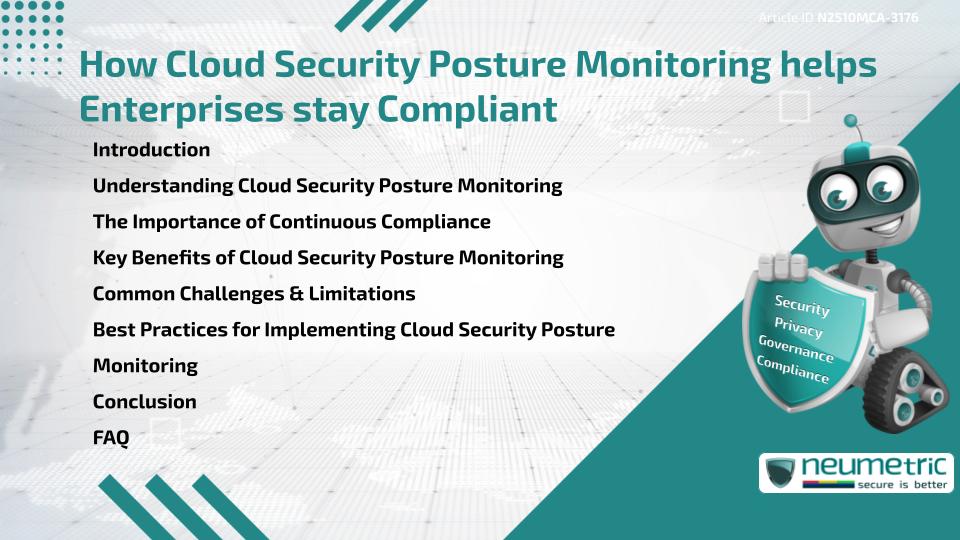Table of Contents
ToggleIntroduction
In today’s fast-evolving digital landscape, maintaining compliance across dynamic Cloud environments has become a top priority for enterprises. Cloud Security Posture Monitoring provides a continuous, automated approach to identifying & mitigating compliance Risks within multi-Cloud & hybrid environments. By assessing configurations, detecting Vulnerabilities & ensuring adherence to Frameworks such as General Data Protection Regulation [GDPR] and Health Insurance Portability & Accountability Act [HIPAA], it helps Organisations protect Sensitive Data & demonstrate accountability.
This article explains what Cloud Security Posture Monitoring is, why it matters for compliance, its benefits & limitations & how enterprises can implement it effectively to maintain a robust & compliant Cloud environment.
Understanding Cloud Security Posture Monitoring
Cloud Security Posture Monitoring (CSPM) is the continuous process of assessing, managing & improving the security configuration of Cloud infrastructure. It automatically detects misconfigurations in platforms such as Amazon Web Services [AWS], Microsoft Azure & Google Cloud.
CSPM tools analyze configuration data against compliance Frameworks & internal Security Policies. They provide visibility into where controls are weak, helping security teams remediate Risks before they lead to data exposure or regulatory violations.
The Importance of Continuous Compliance
Traditional compliance assessments often occur once or twice a year, but Cloud environments change daily. With new instances, databases & services spinning up regularly, maintaining compliance requires constant monitoring.
Cloud Security Posture Monitoring bridges this gap by continuously scanning & auditing configurations against compliance baselines. This approach ensures that Security Controls remain effective even as Cloud resources evolve.
Frameworks such as NIST 800-53 & CIS Benchmarks provide guidance on compliance Standards for Cloud workloads.
Key Benefits of Cloud Security Posture Monitoring
- Improved Visibility: CSPM tools provide centralized dashboards that display compliance status across multiple Cloud platforms.
- Automated Risk Detection: They identify misconfigurations, excessive permissions & policy violations automatically.
- Regulatory Alignment: CSPM ensures compliance with Frameworks such as ISO 27001, PCI DSS, HIPAA & GDPR.
- Faster Incident Response: Continuous Monitoring reduces the time between detection & remediation.
- Operational Efficiency: Automation minimizes manual audits, saving time & reducing human error.
An example of effective compliance automation is discussed by Cloud Security Alliance.
Common Challenges & Limitations
Despite its advantages, Cloud Security Posture Monitoring is not without challenges. False positives can occur if tools are not properly tuned to an organisation’s architecture. Additionally, excessive alerts can overwhelm security teams, leading to alert fatigue.
Another limitation is that CSPM primarily focuses on configuration-level compliance. It does not always detect runtime Threats or insider Risks, which require additional controls such as Cloud Workload Protection Platforms [CWPP].
Best Practices for Implementing Cloud Security Posture Monitoring
- Define a Clear Compliance Framework: Align CSPM with your enterprise’s regulatory obligations.
- Integrate with DevOps Pipelines: Embed compliance checks into continuous integration & deployment [CI/CD] processes.
- Automate Remediation: Use policy-as-code to correct misconfigurations automatically.
- Establish Clear Alert Policies: prioritise critical alerts to prevent fatigue.
- Regularly Review Reports: Schedule compliance reviews to ensure effectiveness.
When implemented properly, CSPM tools create a proactive compliance ecosystem that adapts to rapid Cloud changes.
Conclusion
Cloud Security Posture Monitoring plays a critical role in ensuring that enterprises remain compliant, secure & resilient in complex Cloud ecosystems. By automating compliance checks & providing real-time insights, it helps Organisations reduce Risk exposure, demonstrate regulatory accountability & maintain trust with Customers & Stakeholders.
Takeaways
- Continuous Monitoring ensures compliance across evolving Cloud environments.
- CSPM automates Risk detection & policy enforcement.
- Integrating CSPM into DevOps pipelines enhances compliance efficiency.
- Regular tuning & prioritisation prevent alert fatigue.
- Properly implemented CSPM strengthens Data Protection & Audit readiness.
FAQ
What is Cloud Security Posture Monitoring?
It is the process of continuously monitoring Cloud infrastructure configurations to detect & correct security or compliance Risks.
How does CSPM support compliance efforts?
It compares configurations against Standards like ISO 27001 & GDPR to identify & fix non-compliance issues automatically.
Can CSPM tools prevent data breaches?
While CSPM cannot prevent all breaches, it reduces Risk by ensuring secure configurations & reducing exposure points.
Is CSPM suitable for hybrid environments?
Yes, modern CSPM solutions can monitor both on-premise & Cloud assets through unified dashboards.
What are common CSPM limitations?
CSPM may not detect runtime Threats or insider activities & can generate false positives if not configured properly.
How frequently should CSPM scans run?
Scans should be continuous or at least daily, depending on the rate of infrastructure change.
Can CSPM replace manual audits?
No, it complements manual audits by providing continuous oversight between scheduled assessments.
References:
- NIST 800-53 Compliance Framework
- CIS Benchmarks
- Cloud Security Alliance
Need help for Security, Privacy, Governance & VAPT?
Neumetric provides organisations the necessary help to achieve their Cybersecurity, Compliance, Governance, Privacy, Certifications & Pentesting needs.
Organisations & Businesses, specifically those which provide SaaS & AI Solutions in the Fintech, BFSI & other regulated sectors, usually need a Cybersecurity Partner for meeting & maintaining the ongoing Security & Privacy needs & requirements of their Enterprise Clients & Privacy conscious Customers.
SOC 2, ISO 27001, ISO 42001, NIST, HIPAA, HECVAT, EU GDPR are some of the Frameworks that are served by Fusion – a SaaS, multimodular, multitenant, centralised, automated, Cybersecurity & Compliance Management system.
Neumetric also provides Expert Services for technical security which covers VAPT for Web Applications, APIs, iOS & Android Mobile Apps, Security Testing for AWS & other Cloud Environments & Cloud Infrastructure & other similar scopes.
Reach out to us by Email or filling out the Contact Form…


